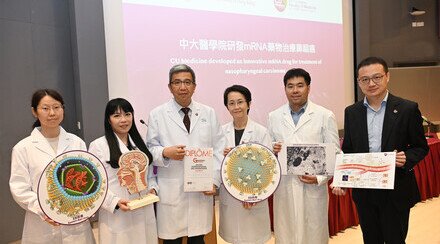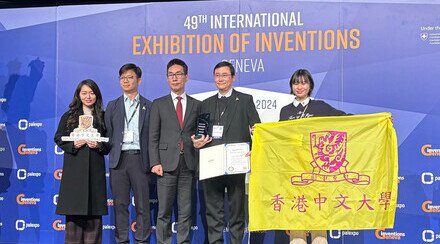CUHK develops a state-of-the-art computational model to accurately forecast viral genetic evolution and facilitate improvement of influenza vaccines’ protective effects
- Influenza viruses continuously evolve to generate seasonal epidemics
- This model forecasts virus changes, facilitating the design of influenza vaccines of greater effectiveness
A research team from The Chinese University of Hong Kong (CUHK)’s Faculty of Medicine (CU Medicine) has developed a cutting-edge computational model, beth-1, to predict genetic evolution in viruses and select representative strains for influenza vaccines. The model works like a weather forecast, projecting virus changes in the future, and has the potential to facilitate optimal vaccine strain selection. This will enhance the protective effect of influenza vaccines.
Validations show that the virus strain predicted by beth-1 is more accurate than existing vaccines in almost 90% of influenza seasons in terms of genetic match to circulating strains. Hence, vaccine effectiveness against the H1N1 and H3N2 viruses, the two common influenza A subtypes in Hong Kong, is expected to be improved by using beth-1. This new model provides a promising and ready-to-use tool to inform influenza vaccine strain selection. The research team has been working closely with research institutions in mainland China to conduct animal experiments for manufacturing more effective vaccines using beth-1. Study details have been published in the renowned journal Nature Communications.

A research team from CU Medicine has developed a cutting-edge computational model, beth-1, to predict genetic evolution in viruses and select representative strains for influenza vaccines. The model works like a weather forecast, projecting virus changes in the future, and has the potential to facilitate optimal vaccine strain selection. Validations show that the virus strain predicted by beth-1 is more accurate than existing vaccines in almost 90% of influenza seasons in terms of genetic match to circulating strains. Hence, vaccine effectiveness against the H1N1 and H3N2 viruses, the two common influenza A subtypes in Hong Kong, is expected to be improved by using beth-1.
Featured in the photo are the research team members. (From left) Dr Cao Lirong; Professor Maggie Wang, Associate Professor; Professor Benny Zee, Director of the Centre for Clinical Research and Biostatistics; and Ms Lou Jingzhi, PhD student, from The Jockey Club School of Public Health and Primary Care at CU Medicine.
Novel model beth-1 was developed through viral genome sequences analyses
The influenza virus continuously evolves to escape human adaptive immunity, generating seasonal epidemics. Influenza vaccine strains therefore need to be updated annually to ensure effectiveness. Prediction of virus evolution has a critical role in facilitating the selection of candidate vaccine strains, which is usually conducted at least nine months ahead of the arrival of the next epidemic season.
Vaccine strain selection involves extensive surveillance and characterisation of the virus in terms of genetics, antigenic evolution and epidemiological profile. This involves a global effort coordinated by the World Health Organization. Current virus evolution forecasting models are developed by researchers in the United States and Europe.
In this study, through extensive analysis of influenza viral genome and epidemics data from history, the researchers developed beth-1, which is able to characterise key parameters quantifying mutational change. The model projects the entire virus population into the future and selects the optimal wild-type strain for consideration as a vaccine strain in the forthcoming flu season.

Professor Maggie Wang says that the research team is now collaborating with research institutions in mainland China to conduct animal experiments for vaccine development based on the predictions of beth-1.

Professor Benny Zee states that the development of beth-1 is an excellent example of translating a multidisciplinary effort into a ready-to-use tool that has potentially wide applications for virology laboratories, vaccine manufacturers and health authorities in influenza vaccine strain selection.
Prediction accuracy of beth-1 outperforms current vaccines in terms of genetic match
To determine its accuracy, researchers applied beth-1 to predict vaccine strains of H1N1 and H3N2 using retroactive virus data. They calculated the average genetic distance between virus strains predicted by different models and sequences of circulating viruses in the targeted season. Results showed that beth-1 is more accurate than current vaccines in 88% of influenza seasons (15 out of 17) in terms of genetic match to circulating strains. Using strains predicted by beth-1 is estimated to raise the expected effectiveness of current vaccines against the H1N1 virus by 13% and H3N2 by 11%. It is estimated that every 5% increase in vaccine effectiveness could prevent one million diseases and 25,000 hospitalisations in one season in the United States alone.
Translating a multidisciplinary effort into a ready-to-use tool
Miss Lou Jingzhi, PhD student from The Jockey Club School of Public Health and Primary Care at CU Medicine and first author of the paper, stated, “Our findings show that beth-1 can provide a highly precise prediction of virus evolution. This provides information to vaccine manufacturers, allowing them to design vaccine candidates with better genetic matching.”
“Beth-1 is a state-of-the-art prediction model to provide viral mutation forecasts,” added Professor Maggie WangHai-tian, Associate Professor from The Jockey Club School of Public Health and Primary Care at CU Medicine. “We are now collaborating with research institutions in mainland China to conduct animal experiments for vaccine development based on the predictions of beth-1. I believe its potential application can also be extended to other rapidly mutating viruses like SARS-CoV-2.”
The study is the result of efforts from experts in multiple disciplines, including statistics, computational biology, epidemiology, virology and immunology. Professor Benny Zee Chung-ying, Director of the Centre for Clinical Research and Biostatistics at CU Medicine’s The Jockey Club School of Public Health and Primary Care, remarked, “Our development of beth-1 is an excellent example of translating a multidisciplinary effort into a ready-to-use tool that will contribute to safeguarding humankind’s well-being. This model has potentially wide applications for virology laboratories, vaccine manufacturers and health authorities in influenza vaccine strain selection, leading to more effective vaccines.”

































































